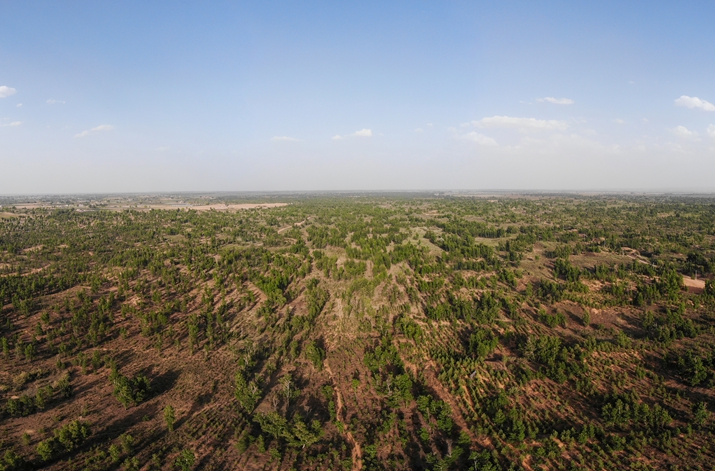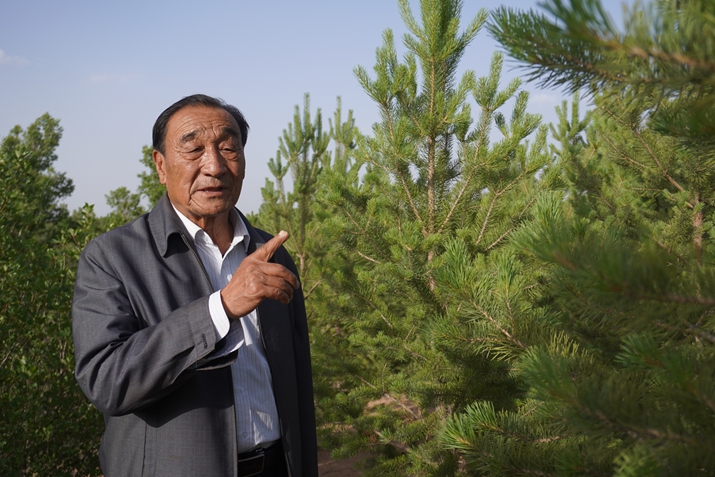
VIDEO link: http://mp42.china.com.cn/video_tide/video/2021/6/18/20216181624005599095_376.mp4
Deadly sands
Shi Guangyin was born into a farmer’s family in Dingbian County, Yulin, Shaanxi Province. The county sits at the conjunction of four provincial-level areas and the southern edge of Maowusu. In the 1950s, 39 percent of the county’s land area was covered by sand, and the overall greenness was only 0.5 percent. Sandstorms hit the area frequently. “We moved nine times in my father’s lifetime as the sandstorm had crashed our houses from the back,” Shi said.
What’s worse, Shi lost a buddy in a sand storm. One day, when he was about 7 or 8, Shi was herding in a flat field with Zhao Huwa, who was only 5. Suddenly, a strong sandstorm rose up and the sky became as dark as night. “I couldn’t see a thing and lost sight of my buddy,” Shi said.
Shi was blown away, and suffered a blackout as he was thrown into a sheep pen in Inner Mongolia Autonomous Region, some 15 km away. When the owner went to check on his sheep in the morning, he found a child coated with a thick layer of sand passed out in the pen. “He saved me and fed me some milk tea,” Shi said. When Shi woke up, the Inner Mongolian named Bart, asked about the boy’s address and sent a message to Shi’s family.
When Shi’s father tracked him down in Inner Mongolia three days later, he was eager to know the whereabouts of his buddy and the sheep. Unfortunately, the 5-year-old had gone missing. “The moving sand had brought so much harm into our life,” said Shi. From then on, he was determined to fight “the demon sand.”
As a matter of fact, “the demon sand,” Maowusu, was a green land of milk and honey back in the fifth and sixth century. However, it degraded step by step into a sand land because of continuous wars and overexploitation in the following 1,000 years. By the time the People’s Republic of China was founded in 1949, Maowusu had become a 42,200-square-km sand land, with its southeastern part located in Yulin.

A tough nut
In the early 1950s, the Chinese Government established several anti-desertification research institutes in sandy areas and moved to green its northern part, an area prone to erosion. In 1978, the Three-North Shelter Forest Program was launched. Extending from the northeastern to the northwestern tip of the country, the shelterbelt is expected to cover more than 40 percent of China’s land area, including Shaanxi. The program is set to continue till 2050. As of 1984, Chinese residents have been encouraged to plant vegetation across contracted sand lands and barren hills.
“I believed it was high time to realize my dream,” Shi told Beijing Review. Back in his 30s, he was a promising chief of a township farm. He quit the stable job despite the objections of his family. “What I wanted was to fight ‘the demon sand’,” he said.
Shi contracted 233 hectares of sand land to plant trees and teamed up with six fellow villagers on his greening mission. He became the first farmer to contract deserted land in China’s fight against desertification.
The biggest challenge was a lack of funding. The team needed at least 100,000 yuan ($42,974 at the exchange rate in 1984) to buy saplings. However, even after literally emptying their purses, all they had was 750 yuan ($322) in total. “Every town was earmarked only 1,000-2,000 yuan ($430-$860). I didn’t receive any government subsidies at that time,” Shi said. He sold all of his livestock, including 84 sheep and one mule. So did other stakeholders. In addition, they took out a loan. Finally, the nascent company managed to raise enough funds to purchase saplings. Fortunately, the weather was in their favor that year. “We had enough rain. And 85 percent of our saplings survived in the first year,” Shi said.
The success prompted the new greening team to be more ambitious. In 1985, they contracted 3,867 more hectares of sand land in Langwosha in the county. Shi knew that a small team couldn’t accomplish the task in due time. Since he couldn’t read, he invited a local teacher to write a poster to recruit more farmers from neighboring provinces and autonomous regions to join. Any household that joined the program would be provided with a 2-square-km plot of arable land, a well and a house. Finally, 127 households with 484 farmers joined the team. Shi set up a joint-stock company in the same year, making it the first greening company established by farmers in the country.
Yet, Langwosha turned out to be a tough nut to crack. “It was a barren sand land without a single patch of grass. You could even spot black beetles marching on,” Shi said. Worse still, the surface temperature in Langwosha varied from 60 plus degrees Celsius in summer to minus 40 in winter. Keeping saplings alive in such an inhospitable environment was a huge challenge. Shi failed twice.
In the first spring, Shi and his team lived in the sand land. “We ate highland barley flatbreads and drank groundwater from a 1-meter-wide hole we dug, using reed stalks as straws,” Shi said. However, in the first year, only 10 percent of the saplings survived the harsh conditions. The following year, only 20 percent did.
Several stakeholders believed the green project to be a waste of money and wanted to give up. Shi respected their choice, but still held on to his dream. “I will not give up till my very last breath,” he told the partners. A number of his relatives and friends said Shi was mad and nicknamed him “the blockhead.”
Before Shi tried a third time in 1987, he visited experts who had studied anti-desertification in Yulin. He was told that barriers were needed to protect the saplings. After the saplings were planted, his team rode a dozen horses to sow the grass seeds. Once the seeds had taken root, they would stabilize the sand and cover the land, hence forging a barrier to protect the saplings. And finally, this way, Shi’s team succeeded to turn Langwosha into a promised green land.

Promising changes
After three decades of hard work, the once barren desert has been turned into a forest. Animals like birds, foxes, badgers and pheasants have made their first appearance in the new oasis. And what excites Shi the most is the fact that some of the ground in Langwosha is now covered in moss. “This means that the water has been better conserved and some moving sand has turned into soil,” Shi Jianyang, the grandson of Shi Guangyin, told Beijing Review. The 25-year-old is a senior student studying forestry technology in Shaanxi.
Shi Guangyin is not alone in his greening efforts. Both individuals and state-owned farms have undertaken numerous bold efforts to green Maowusu and its surrounding towns and cities in the past seven decades. In 2020, the forest coverage in Dingbian reached 29.2 percent, and 93.24 percent of the sand land in Yulin has been improved. This means that Maowusu has become the only sand land tamed by mankind in the world.
The latest data from the Shaanxi Provincial Government show that the occurrence of sand and dust weather conditions in Maowusu dropped from 169 days per year in the 1950s to only 28 days in recent years. The greening area of Shaanxi has expanded by some 400 km northward. “In the past, the moving sand chased us away. Now, we have pushed them back,” Shi Guangyin said.
Following the sand’s containment, the income of local farmers increased. According to Shi Guangyin, in the past, one hectare yielded only 1,500 to 2,250 kg of grain in the sandy area, which brought in just 3,000 to 4,500 yuan ($1,289-$1,934 at the exchange rate in 1984) per year. Now, one hectare can produce more than 15,000 kg of grain per year. Farmers can also plant economic crops, and can make more than 750,000 yuan ($116,550) per hectare per year. “As long as local farmers are better off, I don’t regret a thing, regardless of the hardship. It’s worth living if you can make a difference,” Shi Guangyin said.
In early June, Shi Guangyin was nominated for China’s July 1 Medal, an award given to outstanding members of the Communist Party of China at the centenary of the founding of the world’s largest Party.
Non-stop efforts
Success does not, however, mean that the residents of Maowusu now can rest on their laurels. Further measures are necessary if they want to keep Maowusu forever green. According to Shi Changchun, dean of the Yulin-based Shaanxi Research Institute for Sand Control, all forests in Maowusu are man-made, and their ecosystems are fragile, unstable and unsustainable.
The combination of limited tree variety and high density has led to serious pest infections and tree degeneration in the forest. Also, many trees, like poplars, and bushes planted some 50 years ago are dying out as they have reached the end of their biological cycles. What’s worse, Yulin has been overexploited in the past decades because of its abundant natural resources such as coal and gasoline. Overexploitation has severely damaged the groundwater system, which is vital to the long-term greening of the area.
“Maowusu is still at risk of degrading back into sand land,” Shi Changchun told Beijing Review. He advises that a specific law should be rolled out to better protect the man-made forests, supported by new tailor-made guidelines and funds.
In fact, Yulin’s green fingers, including those of Shi Guangyin, have taken action to upgrade their forests. A total of 110,000 hectares of mixed forest zones with Scots pines as the main vegetation have been planted in Yulin since 2012. “Compared with poplars, for example, Scots pines can stand tall for 150 to 200 years, which means that they can help stabilize the moving sand for centuries to come,” Shi Guangyin told Beijing Review.
He believed that the traditional approach to fight desertification has to be upgraded by high-end technologies. Shi Guangyin suffers from illiteracy. So he donated money to build two elementary schools, offering seats to 280 pupils. “It’d be in vain to fight desertification without knowledge. We need continuous efforts, generation after generation, to protect the environment,” he said.
Source: Beijing Review No.25 – June 24, 2021